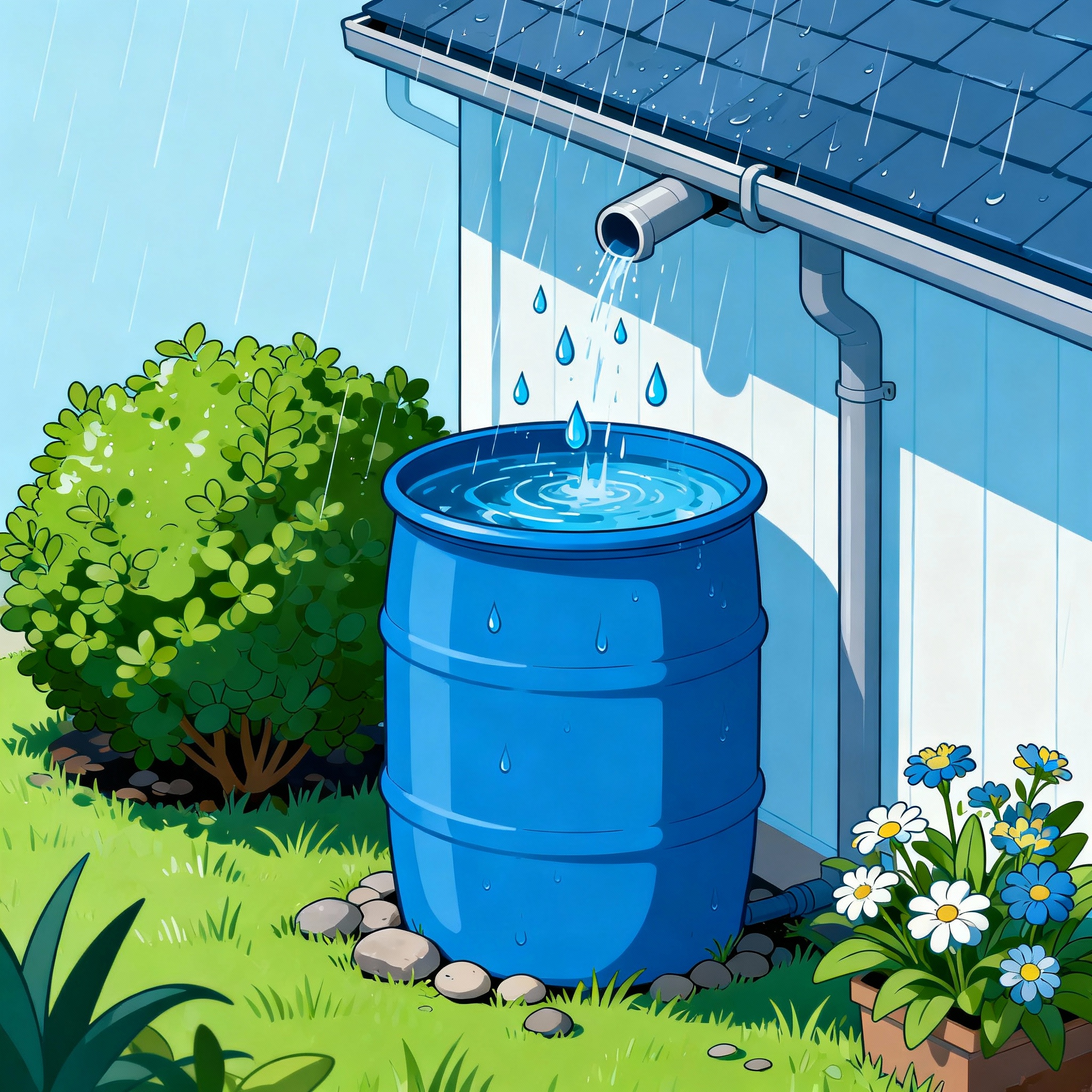Rainwater Collection Calculator
Rain Barrel Sizing Calculator
Rain Barrel Setup Guide
🪣 Choosing a Rain Barrel
Common Sizes:
- 50 gallons – Small gardens, single downspout
- 75 gallons – Medium gardens, moderate use
- 100 gallons – Large gardens, heavy use
- 200+ gallons – Multiple barrels or large tank
Materials: Food-grade plastic, recycled barrels, or purpose-built systems
🔧 Installation Basics
Essential Components:
- Screened lid (prevents mosquitoes)
- Overflow valve or hose
- Spigot near bottom
- Elevated platform (12-18 inches)
- Downspout diverter
Tip: Elevate barrel for better water pressure
💧 Collection Formula
Basic Calculation:
1 inch of rain on 1,000 sq ft = 600 gallons
Formula:
Gallons = (Roof Area × Rainfall × 0.623) × Efficiency
Example: 1,500 sq ft roof, 1 inch rain = 900 gallons potential
🌧️ Rainfall Data
Average Annual Rainfall:
- Seattle, WA: 38 inches
- Portland, OR: 36 inches
- New York, NY: 46 inches
- Phoenix, AZ: 8 inches
- Miami, FL: 62 inches
Tip: Check local weather service for accurate data
🛠️ Maintenance Tips
Regular Upkeep:
- Clean screens monthly
- Check for leaks regularly
- Empty before freezing weather
- Inspect overflow system
- Scrub inside annually
- Remove debris from gutters
⚠️ Safety & Legal
Important Considerations:
- Check local regulations (some areas restrict collection)
- Never drink collected rainwater
- Keep barrel covered to prevent mosquitoes
- Secure barrel to prevent tipping
- Direct overflow away from foundation
🌱 Best Uses for Rainwater
Ideal Applications:
- Garden watering
- Lawn irrigation
- Washing vehicles
- Filling birdbaths
- Outdoor cleaning
- Compost pile moisture
Avoid: Indoor use, drinking, or food crop irrigation in some cases
💰 Cost Savings
Typical Savings:
- Reduces municipal water use
- Average savings: $35-100/year
- Payback period: 2-3 years
- Environmental benefits
- Reduces stormwater runoff
💡 Pro Tips
- ✓ Connect multiple barrels with overflow hoses for greater capacity
- ✓ Install a first-flush diverter to remove initial roof debris
- ✓ Use a soaker hose connected to barrel for efficient watering
- ✓ Paint barrels dark colors to reduce algae growth
- ✓ Level the platform to ensure stable barrel placement
- ✓ Mark water level on outside to monitor usage
Rain Barrel Calculator User Guide
What It Does:
Calculate rainwater harvesting potential from your roof, determine optimal barrel sizing, and plan your rain collection system for water conservation and garden irrigation.
How to Use:
💧 Collection Calculator
Calculate how much rainwater you can harvest from a single rain event.
- Enter Roof Dimensions:
- Length – Roof catchment area length in feet
- Width – Roof catchment area width in feet
- (Measure the portion draining to your downspout)
- Input Expected Rainfall:
- Enter inches of rainfall for a typical storm
- Or use average rainfall data for your area
- Select Collection Efficiency:
- 75% – Average system with normal losses
- 80% – Good, well-maintained system (recommended)
- 85% – Excellent setup with minimal losses
- 90% – Perfect conditions (rare)
- Calculate:
- Click “Calculate Collection”
- Results show:
- Total gallons collected per rainfall event
- Number of barrels needed (55, 75, or 100 gallon)
- Liters collected
- Potential yearly collection
📏 Barrel Sizing Calculator
Determine the right barrel size based on your roof and water usage.
- Enter Roof Area:
- Length and width of catchment area
- Use the section draining to your barrel location
- Input Average Monthly Rainfall:
- Check local weather data for your area
- Use typical monthly average
- Estimate Weekly Water Usage:
- Small garden: 20-30 gallons/week
- Medium garden: 30-50 gallons/week
- Large garden: 50-100+ gallons/week
- Calculate:
- Click “Calculate Barrel Size”
- Results recommend:
- Barrel size (gallons)
- Number of barrels needed
- Monthly collection vs. usage
- Surplus or deficit analysis
📖 Setup Guide
Comprehensive reference for rain barrel installation and maintenance.
What’s Included:
- Choosing a Rain Barrel:
- Common sizes: 50, 75, 100, 200+ gallons
- Materials: Food-grade plastic, recycled barrels
- Features to look for
- Installation Basics:
- Essential components (screen, overflow, spigot)
- Platform elevation (12-18 inches recommended)
- Downspout diverter setup
- Collection Formula:
- 1 inch rain on 1,000 sq ft = 600 gallons
- Formula: (Roof Area × Rainfall × 0.623) × Efficiency
- Rainfall Data:
- Average annual rainfall by city
- How to find local data
- Maintenance Tips:
- Monthly screen cleaning
- Annual interior scrubbing
- Winterization procedures
- Safety & Legal:
- Local regulations (check before installing)
- Mosquito prevention
- Overflow management
- Best Uses:
- Garden watering, lawn irrigation
- Vehicle washing, outdoor cleaning
- NOT for drinking or indoor use
- Cost Savings:
- Average savings: $35-100/year
- Payback period: 2-3 years
- Environmental benefits
Quick Reference:
Collection Formula:
- Gallons = Roof Area (sq ft) × Rainfall (inches) × 0.623 × Efficiency
Common Barrel Sizes:
- 50 gallons – Small gardens, single downspout
- 75 gallons – Medium gardens, moderate use
- 100 gallons – Large gardens, heavy use
- 200+ gallons – Multiple barrels or cistern
Average Water Usage:
- Small vegetable garden: 20-30 gal/week
- Medium flower bed: 30-50 gal/week
- Large garden: 50-100+ gal/week
Quick Tips:
✅ Elevate barrel 12-18 inches – Improves water pressure
✅ Connect multiple barrels – Increase capacity with overflow hoses
✅ Install first-flush diverter – Removes roof debris for cleaner water
✅ Cover barrel – Prevents mosquitoes and algae growth
✅ Empty before winter – Prevents freezing damage in cold climates
Pro Tip: A 1,000 sq ft roof can collect about 600 gallons from just 1 inch of rain! Even in moderate rainfall areas, you can harvest thousands of gallons per year for free garden watering.

Angelina Everly leads the editorial desk at Live Green Gardens, blending practical plant care, hands-on product testing, and approachable outdoor styling. She focuses on step-by-step how-tos, buyer’s guides, and small-space makeovers that work in real life and real budgets. When she’s not comparing pruning shears or setting up a drip kit, you’ll find her creating cozy corners with planters, solar lights, and pollinator-friendly picks—always with clear pros/cons and safety notes so you can buy once and garden happy.

